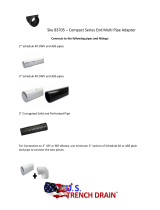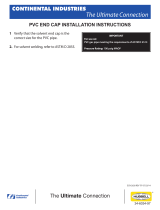
Installation Instructions
Side Wall Vent Kit
Residential Condensing Furnaces
CONTENTS
• Vent terminal base
• Vent terminal cap
• Four (4) 1” long stainless screws
• Four (4) 2” long stainless screws
• Four (4) plastic screw anchors
• Instruction sheet
Figure 1. Terminal Installation
DO NOT APPLY TO NON-CONDENSING FURNACES
THIS KIT IS TO BE USED FOR SIDE WALL VENTING
ONLY. IT IS NOT TO BE USED FOR ROOFTOP
VENTING.
These vent kits are designed for 2” or 3” vent systems. Kit
No. 904347 may be used with 2” or 3” vent pipe, and Kit
No. 904617 may only be used with 2” vent pipe only. The
vent kit must terminate outside the structure and may be
installed with the intake and exhaust pipes located side-
by-side or with one pipe above the other. It is not required
that the terminal be installed in any specifi c orientation.
See Figure 1.
Vent Pipe Material
Vent and combustion air pipe and fi ttings must be one of
the following materials and must conform to the indicated
ANSI/ASTM standards:
Material Standard
Schedule 40 PVC D1785
PVC-DWV D2665
SDR-21* D2241
& SDR-26*
ABS-DWV D2661
Schedule 40 ABS F628
Foam/Cellular Core PVC F891
*In Canada, check the local codes to ensure that SDR is
approved for use. SDR is not approved for all Canadian
installations. All plastic pipe must be certifi ed to ULC S636.
Cement and primer must conform to ATSM Standard D2564
for PVC and Standard D2235 for ABS. When joining PVC
piping to ABS, use PVC solvent cement. (See procedure
specifi ed in ASTM Standard D3138.)
WARNING:
This vent kit is only to be used for venting
Category IV (condensing) furnaces. Do not
use this kit to vent Category I, II or III furnaces.
Failure to follow this warning could result in
fi re, personal injury or death.
CAUTION:
This kit must be installed in strict compliance
with these installation instructions and any
applicable local, state and national codes.
1. Determine the best location for the vent terminal. In
addition to all applicable codes, consider the following
when determining the location:
a. The vent terminal should be located so as to minimize
the total length and number of elbows in the piping.
Consult the furnace installation instructions for the
pipe lengths and number of elbows allowed.
b. Terminal should be positioned where vent vapors
will not damage plants, shrubs or air conditioning
equipment.
c. Terminal should be located where it will not be
affected by wind gusts, light snow, airborne leaves or
other debris, and where it will not allow recirculation
of fl ue gases.

d. Terminal should be located where vent vapors are
not objectionable.
2. Use the vent terminal base as a template to locate
the pipe holes through the wall and the four mounting
holes.
3. If 3” pipe is used, cut two 3-7/8” diameter holes for
the vent and air intake pipe. If 2” pipe is used, cut two
2-3/4” diameter holes.
4. Drill four 3/16” diameter holes for inserting the plastic
screw anchors into the wall.
5. Insert the four plastic screw anchors into the screw
holes and mount the vent terminal base to the wall
using the four long screws provided (#8 pan head,
2” long, SMS Type A 18-8 stainless steel).
6. Assemble the vent terminal cap to the vent terminal
base, using the four short screws provided (#8 pan
head, 1” long, SMS Type A 18-8 stainless steel). See
Figure 2.
7. Install the vent and air intake pipes into the back side
of the openings in the vent terminal base.
8. Seal all gaps between the pipes and the wall.
9. Use RTV silicone sealant to seal the vent pipe to the
vent cap. This will allow the terminal to be disassembled
later if necessary for cleaning. DO NOT use PVC
solvent cement to seal this connection.
10. When using Kit No. 904347, and there is a need to
reduce to 2” diameter pipe, fi eld-supplied reducing
couplings are required. See Figure 3.
11. Operate the furnace for at least 15 minutes to make
sure that it is working properly and that all piping
joints are sealed to prevent the escape of combustion
products into the home.
12. For installations where two or more furnaces are to
be vented using these kits, there must be a minimum
of 18 inches clearance between the vent terminal
caps. To prevent condensate freezing problems, do
not install multiple vent kits above one another.
WARNING:
Do not operate the furnace without the vent
terminal cap in place, as recirculation of fl ue
products may occur. This can also cause wa-
ter to collect inside the combustion air pipe
where it can fl ow back to the furnace burner
box. Failure to follow this warning can result
in product damage or improper operation,
personal injury or death.
O’Fallon, MO
Specifi cations and illustrations subject to change
without notice and without incurring obligations.
Printed in U.S.A. (03/07)
7087410 (Replaces 708477A)
¢708741*¤
7087410
Figure 2.
Pipe Reduction for Kit No. 904347.
Figure 3.
/

